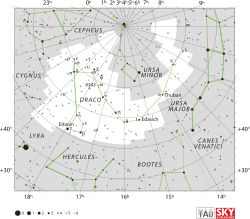Eta Draconis

| |
| Observation data Epoch J2000.0 Equinox J2000.0 | |
|---|---|
| Constellation | Draco |
| Right ascension | 16h 23m 59.48594s[1] |
| Declination | +61° 30′ 51.1699″[1] |
| Apparent magnitude (V) | +2.73[2] |
| Characteristics | |
| Spectral type | G8 III[2] |
| U−B color index | +0.70[3] |
| B−V color index | +0.91[3] |
| Astrometry | |
| Radial velocity (Rv) | –14.3[4] km/s |
| Proper motion (μ) | RA: –17.02[1] mas/yr Dec.: +56.95[1] mas/yr |
| Parallax (π) | 35.42 ± 0.09[1] mas |
| Distance | 92.1 ± 0.2 ly (28.23 ± 0.07 pc) |
| Absolute magnitude (MV) | +0.58[5] |
| Details | |
| Mass | 2.55[2] M☉ |
| Radius | 11[6] R☉ |
| Luminosity | 60[2] L☉ |
| Surface gravity (log g) | 2.82[2] cgs |
| Temperature | 5,055[2] K |
| Metallicity [Fe/H] | –0.04[2] dex |
| Rotational velocity (v sin i) | 8[7] km/s |
| Age | 550[2] Myr |
| Other designations | |
Eta Draconis (η Dra, η Draconis) is a star in the northern circumpolar constellation of Draco. Despite having an apparent visual magnitude of only +2.73,[2] it is the second brightest star in this generally faint constellation. Based upon parallax measurements collected during the Hipparcos mission, this star is located at a distance of about 92.1 light-years (28.2 parsecs) from Earth.[1]
Eta Draconis is a large star with 2.55[2] times the mass of the Sun. The spectrum matches a stellar classification of G8 III,[2] with the luminosity class III indicating this is an evolved giant star that has exhausted the supply of hydrogen at its core. It reached this stage in only 550[2] million years because higher mass stars such as this consume the supply of hydrogen more rapidly than the Sun. The measured angular diameter of this star, after correction for limb darkening, is 3.72 ± 0.07 mas.[9] At the estimated distance of Eta Draconis,[1] this yields a physical size of about 11 times the radius of the Sun.[6] From its extended envelope, it is radiating around 60 times the luminosity of the Sun at an effective temperature of 5,055 K,[2] giving it the yellow glow of a G-type star.[10]
A nearby stellar companion is located at an angular separation of 5.1 arcseconds from Eta Draconis. This is an 8.8 magnitude K-type main sequence star with a stellar classification of K2 V.[11] At the estimated distance of this star system, the two stars are separated by a physical distance of at least 140 AU and require at least a millennium to complete an orbit.[12]
Name
η Draconis, together with ζ Dra (Al Dhibah), were Al Dhīʼbain, the Duo Lupi in Arabic, the Two Hyaenas or Wolves, lying in wait for the Camel's Foal, the little star Al Rubaʽ, protected by the Mother Camels.[13]
In Chinese, 紫微左垣 (Zǐ Wēi Zuǒ Yuán), meaning Left Wall of Purple Forbidden Enclosure, refers to an asterism consisting of η Draconis, ι Draconis, θ Draconis, ζ Draconis, υ Draconis, 73 Draconis, γ Cephei and 23 Cassiopeiae.[14] Consequently, η Draconis itself is known as 紫微左垣三 (Zǐ Wēi Zuǒ Yuán sān, English: the Third Star of Left Wall of Purple Forbidden Enclosure.),[15] representing 少宰 (Shàozǎi), meaning The Second Premier.[16] Possibly, 少宰 (Shàozǎi) is westernized into Hea Tsae by R.H. Allen with meaning "the Lowest Steward" but it was for θ Dra[17]
References
- 1 2 3 4 5 6 7 van Leeuwen, F. (November 2007), "Validation of the new Hipparcos reduction", Astronomy and Astrophysics, 474 (2): 653–664, arXiv:0708.1752
 , Bibcode:2007A&A...474..653V, doi:10.1051/0004-6361:20078357
, Bibcode:2007A&A...474..653V, doi:10.1051/0004-6361:20078357 - 1 2 3 4 5 6 7 8 9 10 11 12 13 Takeda, Yoichi; Sato, Bun'ei; Murata, Daisuke (August 2008), "Stellar parameters and elemental abundances of late-G giants", Publications of the Astronomical Society of Japan, 60 (4): 781–802, arXiv:0805.2434
 , Bibcode:2008PASJ...60..781T, doi:10.1093/pasj/60.4.781
, Bibcode:2008PASJ...60..781T, doi:10.1093/pasj/60.4.781 - 1 2 Nicolet, B. (1978). "Photoelectric photometric Catalogue of homogeneous measurements in the UBV System". Astronomy and Astrophysics Supplement Series. 34: 1–49. Bibcode:1978A&AS...34....1N.
- ↑ Wilson, Ralph Elmer (1953). General Catalogue of Stellar Radial Velocities. Washington: Carnegie Institution of Washington. Bibcode:1953GCRV..C......0W.
- ↑ Pizzolato, N.; Maggio, A.; Sciortino, S. (September 2000), "Evolution of X-ray activity of 1-3 Msun late-type stars in early post-main-sequence phases", Astronomy and Astrophysics, 361: 614–628, Bibcode:2000A&A...361..614P
- 1 2 Lang, Kenneth R. (2006), Astrophysical formulae, Astronomy and astrophysics library, 1 (3rd ed.), Birkhäuser, ISBN 3-540-29692-1. The radius (R*) is given by:
- ↑ Bernacca, P. L.; Perinotto, M. (1970). "A catalogue of stellar rotational velocities". Contributi Osservatorio Astronomico di Padova in Asiago. 239 (1). Bibcode:1970CoAsi.239....1B.
- ↑ "eta Dra -- Variable Star", SIMBAD Astronomical Object Database, Centre de Données astronomiques de Strasbourg, retrieved 2012-02-20
- ↑ Richichi, A.; Percheron, I.; Khristoforova, M. (February 2005), "CHARM2: An updated Catalog of High Angular Resolution Measurements", Astronomy and Astrophysics, 431: 773–777, Bibcode:2005A&A...431..773R, doi:10.1051/0004-6361:20042039
- ↑ "The Colour of Stars", Australia Telescope, Outreach and Education, Commonwealth Scientific and Industrial Research Organisation, December 21, 2004, retrieved 2012-01-16
- ↑ Eggleton, P. P.; Tokovinin, A. A. (September 2008). "A catalogue of multiplicity among bright stellar systems". Monthly Notices of the Royal Astronomical Society. 389 (2): 869–879. arXiv:0806.2878
 . Bibcode:2008MNRAS.389..869E. doi:10.1111/j.1365-2966.2008.13596.x.
. Bibcode:2008MNRAS.389..869E. doi:10.1111/j.1365-2966.2008.13596.x. - ↑ Kaler, James B., "AL DHIBAIN "PRIOR" (Eta Draconis)", Stars, University of Illinois, retrieved 2012-02-20
- ↑ Star Name - R.H Allen p. 202
- ↑ (Chinese) 中國星座神話, written by 陳久金. Published by 台灣書房出版有限公司, 2005, ISBN 978-986-7332-25-7.
- ↑ (Chinese) AEEA (Activities of Exhibition and Education in Astronomy) 天文教育資訊網 2006 年 6 月 10 日
- ↑ (Chinese) English-Chinese Glossary of Chinese Star Regions, Asterisms and Star Name Archived August 10, 2010, at the Wayback Machine., Hong Kong Space Museum. Accessed on line November 23, 2010.
- ↑ Star Name - R.H. Allen p. 210